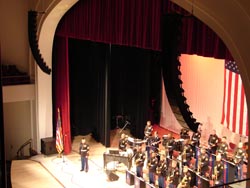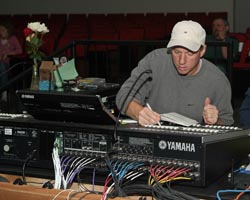Independence Day

The Marine Corp Reserve Band of New Orleans played two sets with a 20-piece jazz ensemble and a 40-piece concert band for Independence Memorial Hall's opening concert, presenting the debut of a new system featuring 26 NEXO GEO S main speakers.independence, ks-The last make-over for the 84-year old Independence Memorial Hall was 1979, and in recent years, audiences had registered complaints about the sound system. Then six years ago, the city of Independence instituted a quality of life sales tax to raise funding for projects such as the renovation of Independence Memorial Hall and its 2,000-seat auditorium.
The $3.7 million renovation project for Memorial Hall and its auditorium involved both an architect and an acoustician: GLPM Architects, Kansas City, MO, Tom McCasland project head, and Bob Coffeen, acoustical consultant and professor at Kansas University. Audio systems design and commissioning was by MSM Systems, Lawrence, KS.
The new audio system includes 26 NEXO GEO S main speakers and two CD18 subs driven by 10 Yamaha PC-1N amps. A Yamaha M7C7-48 digital console serves as FOH console. (A built-in transformer isolated splitter snake is included for adding a second monitor console on-stage, as are eight EAW SM series floor monitors powered by two Yamaha PC4801N amps.)
In early November 2004, MSM president Kent Clasen met with a task force appointed by the mayor of Independence for the renovation of the hall: Mike Flood, general manager of Cable ONE in Independence, and Rusty Scott, facilities manager, were key members for sound system selection. "The input we received from the community," said Flood, "indicated that they wanted a better sound system that would work for small productions and graduations, as well as for plays, musicals, and professional concerts." Flood also received a request from the theater community for wireless. Clasen speced over 20 channel of wireless, using Shure ULX Professional units with Shure wireless lapel Omnis and Countryman E6 EarSet mics.
Out With The Old, In With Line-Arrays
System's designer Clasen keyed on the client's desire for quality sound and the variety of productions the auditorium needed to support. "Based on the EASE model of the hall, we decided that NEXO arrays were our first choice to demo," said Clasen. "We rented a theatre [Independence Hall was in use at the time] and invited Tom McCasland from GLPM, and acoustical consultant Bob Coffeen. Joe Rimstidt from NEXO brought in a rig for us. We didn't have time to hang the system properly due to a scheduled rehearsal, but we could still determine that the arrays were right for the project design."
This decision held, even after other manufacturer-sponsored demos.
Before the demo, the client expressed some concern that flown arrays left and right (13 speakers each side) would not be a good architectural match for the Hall. But actually seeing the speakers makes a much stronger impression. In this instance, says Clasen, the client not only agreed GEO arrays were unobtrusive, but was very positive about their high-tech look.

Chris Moore, primary audio operator for many events in the hall over the last 15 years, was at the Yamaha M7CL for several new productions, and says training from Kent Clasen and Yamaha were very helpful, but nothing beat weeks of rehearsals to get him confotable with the console.
"There are a number of small format line-arrays on the market," said Clasen, "but NEXO has the best sound quality I have found, and offers the most in adjustable horizontal dispersion. Some loudspeaker manufacturers seem to forget that we still need to consider the horizontal dispersion pattern when designing a sound system."
A daily selection of the top stories for AV integrators, resellers and consultants. Sign up below.
The tuning and calibration took place over several days. "After much analysis with SMAART and several microphone locations," said Clasen, "we ended up aiming each array up two degrees and using only two filters on the total EQ. We had a +/- two decibels at mid frequencies in every one of the 2000 seats. The GEO line array system is capable of 115dBc peaks at FOH 60 feet from the stage."
The deep overhang of the balcony-nearly half of the auditorium's 2,000 seats are located here-dictated a small delay system consisting of eight EAW UB52 loudspeakers driven by two Yamaha PN4801 amps, tied to a Shure P4800 speaker delay system.
A Digital Console
In the early stages of the project, Clasen was leaning toward an analog console. "I had reservations about a digital console causing difficulties for various operators."
For general manager Flood: "The M7CL had everything we needed in one package. Since this console has everything built in, it saved us money and it certainly saved us space." Clasen agreed: "The FOH space on the cement floor was cut out and lowered 14 inches to preserve sight lines. That didn't leave us much room for outboard gear. The M7CL eliminated the need for a whole rack of effects, gates, processors."
"The Yamaha digital console and NEXO arrays," said Flood, "are central to marketing our facility."
The AVNetwork staff are storytellers focused on the professional audiovisual and technology industry. Their mission is to keep readers up-to-date on the latest AV/IT industry and product news, emerging trends, and inspiring installations.
